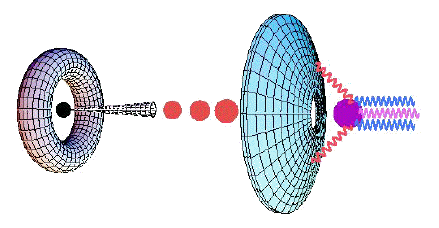

may be formed by CannonBall pulses of Accreting Matter in SuperNova explosions. In A CannonBall Model of Gamma-Ray Bursts: SuperLuminal Signatures (astro-ph/0008474), Dar and De Rujula say: "... A core-collapse SN results in a compact object and a fast-rotating torus of non-ejected fallen-back material. ... the long-duration gamma ray bursts (GRBs) and their afterglows are produced by highly relativistic jets emitted in supernova explosions. We propose that the result of the event is not just a compact object plus the ejecta: within a day, a fraction of the parent star falls back to produce a thick accretion disk. The subsequent accretion ...(not shown [in the above figure]) generates jets and constitutes the GRB "engine", as in the observed ejection of relativistic "cannonballs" of plasma by microquasars and active galactic nuclei. The GRB is produced as the jetted cannonballs exit the supernova shell reheated by the collision, re-emitting their own radiation and boosting the light of the shell. They decelerate by sweeping up interstellar matter, which is accelerated to cosmic-ray energies and emits synchrotron radiation: the afterglow. We emphasize here a smoking-gun signature of this model of GRBs: the superluminal motion of the afterglow ...".
In GAMMA-RAY BURSTS AND THE SOCIOLOGY OF SCIENCE, hep-ph/0306140, Alvaro de Rujula says: "... I discuss what we have learned about Gamma-Ray Bursts (GRBs) by studying their afterglows, and how these are interpreted in the generally-accepted fireball model of GRBs, as well as in the generally-unaccepted cannonball model of the same phenomena. ... Some three times a day, on average, gamma-ray bursts (GRBs) reach the upper atmosphere from isotropically distributed sky locations. Much of their energy is in photons of a few hundred keV, with a total fluence of 10^(-6) erg s^(-1), give or take a couple of orders of magnitude. GRB durations range from tens of milliseconds to hundreds of seconds, with varied time structures generally consisting of fast rising and declining, isolated or partially-superimposed pulses. The distribution of GRB durations is bimodal, with a trough at [about] 2 s, separating "short" from "long" GRBs ... GRBs are a highly-beamed but relatively- small fraction of the energetic budget of a supernova (SN) explosion. ... Our information about the once totally mysterious gamma-ray bursts increased spectacularly in the past few years. The rapid directional localization of GRBs by the satellites BeppoSAX, Rossi and by the Inter-Planetary Network of spacecrafts led to a flurry of progress. The crucial discovery ... was the existence of "afterglows" (AGs) of long-duration GRBs: not surprisingly, a GRB "event" does not end as the gamma-ray flux becomes undetectably small. The source continues to emit light at all smaller observable frequencies, ranging from X-rays to radio waves, and to be observable for months, or even years. The fact that these remaining emissions can be very well localized in the sky has led to the discovery of the GRBs' host galaxies ... the measurement of their redshifts ... that verified their cosmological origin; the identification of their birthplaces - mainly star formation regions in normal galaxies - and the first evidence for a possible association (in time and location) between GRBs and supernova explosions .... that of GRB 980425 and the supernova SN1998bw. ... The fact that the progenitors of long GRBs are core-collapse SNe, long advocated in the CB model, has received spectacular support after this talk was delivered ... the CB model explains well and in an extremely simple fashion practically all aspects of the data on long-duration GRBs. ... So far, the CB model has encountered no problems in its confrontation with data.
It is in its confrontation with humans that the model fares the worst. ... a ... referee ... reports: "The claim that the CB model works better than the standard fireball models is not made in a way that would convince any objective reader". He does not bother to say why. To me this sounds as being impermeable to facts. Finally, we complain to the editor, who responds: "I have no claim to infallibility". My colleagues and I have written some 18 papers on GRBs in the CB model, the first four of which were rejected on grounds very similar to the above. That is, not once on the basis of scientific critique. This is very discouraging. One is tempted to entitle all of one's papers on the subject "Mission Impossible". ... In other realms of science the existence of a sensible model challenging the standard lore would be very welcome, as opposed to olympically ignored. Viki Weisskopf used to say "Physics is best done in a hostile environment". Surely my coauthors and I are, in this sense, obliged to quite a few ominous and anonymous colleagues. But we would not have been able to survive the environment for long, had we not held prior tenured positions. ...".
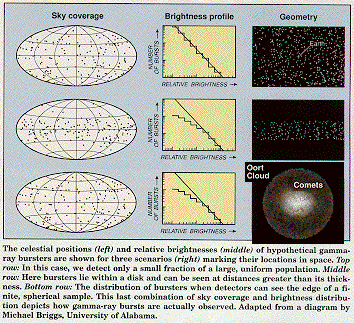
(from Sky and Telescope, September 1996)
If the distant galaxies are where the GRBs are located, then the GRBs must be very energetic. GRB971214 is near a galaxy that is about 12 billion light years from Earth and, in the 7 May 1998 issue of Nature, Kulkarni et. al. estimate that the distance redshift z = 3.42 implies an energy of 3x10^53 erg in gamma-rays alone, if the emission is isotropic.
Kulkarni et. al. sat that the most likely source of such energy is the Pair-ElectroMagnetic Pulse (PEM Pulse) in the Dyadosphere of a Black Hole.
Remo Ruffini, Bianco, Fraschetti, and Xue, in astro-ph/0106532, say: "... Given the very accurate data from the BATSE experiment and RXTE and Chandra satellites, we use the GRB 991216 as a prototypical case to test the EMBH theory linking the origin of the energy of GRBs to the electromagnetic energy of black holes. The fit of the afterglow fixes the only two free parameters of the model and leads to a new paradigm for the interpretation of the burst structure, the IBS paradigm. ... in GRBs we can distinguish an injector phase and a beam-target phase.
The injector phase includes
The injector phase terminates at the point where the plasma transparency condition is reached and the ... proper-gamma ray burst ... P-GRB is emitted.
The beam-target phase addresses the interaction of the ... afterglow ... ultra-high energy baryons ... ABM pulse, namely the beam generated during the injection phase, with the ... interstellar medium ... ISM as the target. It gives rise to
... It leads as well to a reconsideration of the relative roles of the afterglow and burst in GRBs... Such differentiation leads to a natural possible explanation of the bimodal distribution of GRBs observed by BATSE. The agreement with the observational data in regions extending from the horizon of the EMBH all the way out to the distant observer confirms the uniqueness of the model. ... The intrinsic simplicity of the EMBH model of GRBs, shown here to depend only from two parameters, offers an unique opportunity to use GRBs as "standard candles" in cosmology. ...".
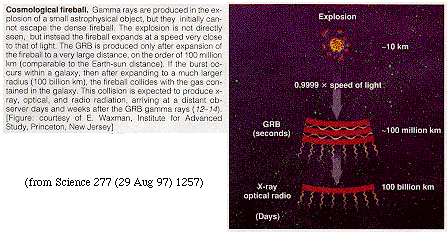
On 28 February 1997, the Beppo-SAX satellite observed a GRB and an X-ray source near the position of the GRB. Within a day, Paradijs, Groot, and Galama made an image of that part of the sky, using telescopes at the Canary Islands. Eight days later, they made a second image, and found that one point of light had faded. On 13 March 1997, they looked at the faded object (Optical Transient) with ESO's 3.5 meter telescope at La Silla, Chile, and found a small dim galaxy (Extended Soutce). If in fact the galaxy is the X-ray source, and if in fact the X-ray source is the GRB, then it would be established that the GRB is in a distant galaxy, at cosmological distances. An article about the observations of Paradijs et. al. is in Science 275 (21 March 1997) 1738. A Hubbble Space Telescope press release on 16 September 1997 described observations made on 5 September 1997 of the Optical Transient and Extended Source, stating:
"1. The continued visibility of the [Optical Transient identified with the burst], and the rate of its decline over time, support theories that the light comes from a gamma-ray burst in a "relativistic" fireball (expanding at the speed of light) located at extragalactic distances. A burst in our galaxy, at the observed brightness, would have been slowed by the interstellar medium within the first few weeks, and faded from sight by now.
2. The observations contradict earlier claims [such at those stated in Caraveo, Mignani, Tavani, and Bignami, and in Sky and Telescope weekly news bulletin of 19 April 1997] that the gamma-ray burst is moving against the sky background [proper motion]. Had proper modtion been detected, the gamma-ray burst would have had to be no further away than about 30,000 light-years, or about the distance to the center of the galaxy.
3. The fuzzy companion object the fireball is embedded in [the ExtendedSource] - as first confirmed by Hubble in March 26 observations - has not noticeably faded. This means it is not a relatively nearby nebula produced by the explosion, but in all likelihoos a host galaxy.
4. Since the burst did not occur at the center of the host galaxy, but near its edge, the gamma-ray burst phenomenon is not related to activity in the nucleus of a galaxy. The Hubble observations support the "fireball" model for a gamma-ray burst.
These observations are consistent with colliding neutron stars creating the fireball, but do not require it. "
A DISTANCE that is NOT DEPENDENT on IDENTIFICATION of a GRB with an OPTICAL SOURCE MUST come from OBSERVATION of the GAMMA RAYS THEMSELVES. In astro-ph/9705128, Hurley et. al. attempt to calculate a lower bound on the distance of the 28 February 1997 GRB by looking at the arrival times of the signal at different satellites (Ulysses and SAX). They compare those time differences with the time differences due to plane-wave arrival times from the direction of the GRB. If the GRB source has a spherical curved wave-front, then you can determine the distance to the GRB source. They find that the wave-front is consistent with a plane wave (infinite distance) and at least has radius of curvature greater than 11,000 AU. However, their method does not apply if a GRB source does not produce a spherical curved wave-front..
Francisco J. Castander and D. Q. Lamb, in astro-ph/ 9803324 (30 Mar 1998), The Galactic Extinction Toward GRB 970228 and Its Implications, say: " The IRAS 100 micron image of the GRB 970228 field shows that the amount of galactic dust in this direction is substantial ... if the extended source in the burst error circle is extragalactic and therefore lies beyond the dust in our own galaxy, its optical spectrum is very blue: its observed color ... is consistent only with a starburst galaxy, an irregular galaxy at z >1:5, or a spiral galaxy at z >2. On the other hand, its observed color and surface brightness ... are similar to those expected for the reflected light from a dust cloud in our own galaxy, if the cloud lies in front of most of the dust in this direction."
Observations of another GRB on 8-10 May 1997 were reported by Sky and Telescope in its weekly news bulletin of 16 May 1997 and in IAU Circular 6655. "On May 8th BeppoSAX pinpointed a gamma-ray burst in the far-northern constellation Camelopardalis.Within hours, Howard E. Bond (Space Telescope Science Institute) imaged the burst's environs with the Kitt Peak 36-inch reflector. Returning to the field the next night, he found that one starlike point had brightened by about 1 magnitude (a 2.5-fold increase). Subsequent observations by researchers worldwide found that the variable "star" peaked around May 10th at 20th magnitude and has since faded.The variable lies at the same position as the GRB to the accuracy with which this can be determined --about one arcminute. ... Caltech astronomers [obtained] a decent spectrum with the Keck II telescope on Mauna Kea. This spectrum shows the fingerprint of intervening material, which has selectively absorbed light of certain wavelengths. The absorptions appear to be caused by iron and magnesium ions, but at wavelengths stretched nearly twofold by the expansion of space. This suggests that the burst took place at a distance of several billion light-years. ... According to Chryssa Kouveliotou (Universities Space Research Association) and her colleagues, if the gamma rays seen on May 8th really do lie at the distance of the light-absorbing material, the outburst produced 6 x 10^50 ergs each second at its brightest. This is comparable to the amount of energy our Sun has emitted over the last 5 billion years -- making the energy-producing mechanism of [cosmologically distant] GRBs more mysterious than ever."
Twinkling fluctuations were seen in the radio counterpart of the 8 May 1997 GRB. According to the Sky and Telescope weekly news bulletin of 19 Sepember 1997: ":Astronomers have a new clue to the nature of gamma-ray bursts, mysterious eruptions of high-energy radiation that pop off about once a day at random points on the sky. Earlier this year, on May 8th, one such burst was recorded not only by orbiting gamma-ray detectors, but also by the BeppoSAX X-ray satellite, which pinpointed the burst's location on the celestial sphere almost instantly. Ground-based optical telescopes swung into action and found a previously unknown source of visible light at the position of the gamma-ray event. This soon faded, but not before astronomers were able to deduce that it was billions of light-years away, well outside our own galaxy. Radio telescopes observed a counterpart too, and over several weeks this source fluctuated in intensity like a twinkling star. Unlike visible twinkling, which is caused by irregularities in Earth's atmosphere, radio twinkling is caused by irregularities in the gas clouds pervading the Milky Way. Just as planets don't twinkle due to their finite angular size, so too should radio sources not twinkle if they are sufficiently large. As Shri Kulkarni (Caltech) and Dail Frail (National Radio Astronomy Observatory) report in Nature this week, the radio source coincident with the May 8th gamma-ray burst did stop twinkling after awhile, suggesting that the source of the radio emission had grown in angular size. From their detailed studies, Kulkarni and Frail deduce that the fireball must have expanded to a diameter of at least a tenth of a light-year since the eruption last May, implying that debris is flying outward at least 85 percent of the speed of light. This means the burst itself must have been outrageously energetic -- perhaps resulting from the collision of two neutron stars in a distant galaxy, or even the collision of two black holes." Further details are in astro-ph/9709199 by Waxman, Kulkarni, and Frail.
Blandford and Helfand, in astro-ph/9902004, say "... The recent gamma ray burst, GRB 990123 has a redshift zs = 1:61 and appears to have an energy E = 3 x 10^54 erg, and a peak luminosity Lmax = 10^53 erg/sec ... assuming isotropic emission. This is ten times larger than hitherto reported and in excess of the rest mass of a solar mass object. Optical observations have revealed an intervening galaxy with redshift zd = 0:286 displaced from the line of sight by 1.8 +/- 0.4". This raises the possibility that the burst is enhanced by gravitational lensing. We argue that multiple images are not present within the burst profile or within 15 minutes of the burst trigger. Preliminary inspection of the intervening galaxy image allows us to set a limit on the magnification of M < 60; if subsequent analysis of Ulysses data extends this window to about 1 day, and/or if a fainter burst is not observed within a few weeks, the magnification is at most modest (M < 10), and the burst remains the most intrinsically luminous event yet observed. ...".
Fenimore, Ramirez-Ruiz, and Wu, in astro-ph/9902007, say "... GRB990123 was a long complex gamma-ray burst with an optical transient that started early within the gamma-ray phase ... . The peak and power law decay of the early optical emission strongly indicates the presence of a decelerating relativistic shell during that phase. Prior to this burst, it was not known if the shell decelerated during the burst, so an external shock origin for the gamma rays was still possible. If the gamma-rays are produced in the external shock, then the pulse widths should reflect the observed deceleration of the shell and increase by about 2.3. We analyze the fine time structure observed in the gamma-ray data from BATSE and determine that the width of the peaks do not increase as expected for a decelerating shell; the later pulses are, at most, a factor of 1.15 longer than the earlier pulses. We also analyze the variability to determine what fraction of the shell's surface could be involved in the production of the gamma rays, the so-called surface filling factor. For GRB990123 we find a filling factor of 0.008. The lack of pulse width evolution eliminates the only remaining kinematically acceptable external shock explanation for the gamma-ray phase and, thus, the gamma rays must originate at a central engine. ...".
Cline, Matthey, and Otwinowski, in their Study of Very Short Gamma-Ray Bursts, "... carried out a detailed study of the morphology of gamma-ray bursts (GRBs) with time duration less than 100 ms ... [they] show that these bursts are very different from the rest of the GRB events. The short bursts appear to be nearly identical, suggesting a separate class of GRBs .. [and] ... show that the short bursts have a Euclidean space-time distribution ... that implies that these sources are likely. ... local or Galactic ... ".
No radio, optical, or X-ray counterpart was observed for the bright gamma-ray burster GRB970111. In astro-ph/9704180, Frail, Kulkarni, Costa, Frontera, Heise, Feroci, Piro, Dal Fiume, Nicastro, Palazzi, and Jager report on a comprehensive radio monitoring program of the bright gamma-ray burster GRB970111. These VLA observations were made at a frequency of 1.4 GHz and span a range of post-burst timescales between 28 hours and one month. Despite extensive sampling at sub-milliJansky sensitivities, no radio source was detected above 0.5 mJy in the current best error box (~14 arcmin^2) for GRB970111. A highly unusual radio source, VLA J1528.7+1945, was seen to drop in flux density by a factor of two in our monitoring period but it lies outside the error box and thus it is unlikely to be related to GRB970111. Cosmological fireball models of gamma-ray bursts make predictions of late-time emission occurring at longer wavelengths. The absence of a flaring or fading radio counterpart to GRB970111 provides strong constraints on these models.
Further, Scharf, Jahoda, and Boldt, in their paper astro-ph/9506008, On the Measurement of a Cosmological Dipole in the Photon Number Counts of Gamma-Rays Bursts, conclude that
"... the fluence and number weighted dipoles are inconsistent for the null hypothesis [that GRBs track the cosmological CMB distribution] at roughly the 2-sigma level.
"... the correlation with the direction of motion of the Local Group is more significant ...
"... Together these results could indicate that a non-negligible fraction of gamma-ray bursts originate within the local (anisotropic) universe.
"There is no evidence of correlation with the direction expected in a halo model."
Although Scharf, Jahoda, and Boldt would like to analyze a catalogue of 10,000 bursts rather than the 410 they used, and they do not rule out distance scales intermediate between galactic halo and cosmological distances, their results support consideration of the hypothesis that some of the GRBs are relatively local, in the solar neighborhood at a distance about 1000 AU, roughly the distance of an inner Oort cloud of comets.
In A Burst of Speculation, Katz discusses collisions among comets in the Oort cloud. Gamma ray production by sonoluminescence in the water formed from cometary ice in colliding comets may be feasible.
Ti-Pei Li discusses a Heliospheric Origin of Gamma-Ray Bursts, due to large-voltage and high-temperature pinch plasma columns produced by disruptive electrical discharges in the heliosphere.
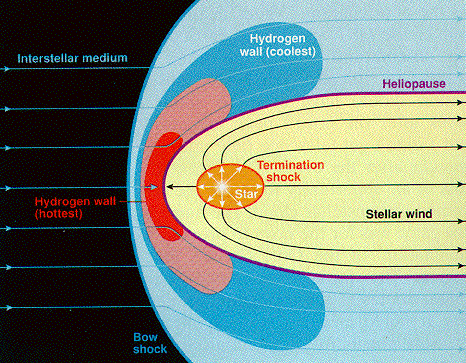
In this figure from Sky and Telescope (June 1997 p. 102), the termination shock region is the region whose geometry is most like the distribution of GRBs, as the heliopause, hydrogen wall, and bow shock regions are asymmetrical with respect to the direction movement of the Sun through the interstellar medium. The distance scales are probably on the order of 100 AU, but are not known for certain since Pioneer and Voyager spacecraft have not reached the boundaries of the regions.
In Gamma Ray Bursts and CETI, I discuss the possibility that GRBs could be Communication by Extra-Terrestrial Intelligences using gamma-ray laser signals focussed by THE SUN AS A GRAVITATIONAL LENS:
In this gif, the distance is measured in units of Neptunes's orbital radius, which is about 30 AU. (see Sky & Telescope, Nov. 1983, p. 387)
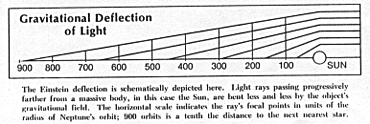
The focal length of the sun as a gravitational lens is about 540 AU, or 18 times Neptune's orbit radius. Any beam of electromagnetic radiation (whether light, radio waves, or gamma rays) hitting the sun from about 540 AU or farther out is focussed by the sun's gravitational field into a beam that could be used for communication.
ENERGETICS OF CETI GRAVITATIONAL LENS GRBs:
If they were spherically symmetric sources, GRBs located 100 light-hours (720 AU) from the sun would radiate about 10^(26) erg.
However, if the ETI were beaming the gamma rays in the direction of the sun, confining the beam to about 10^(-4) steradian, the earth would still be in the beam and the required energy would be about 10^(21) erg.
For comparison, about 10^(21) erg is roughly
the energy of fission of 1 kg of U^(235),
or of the annihilation of 1 gm of matter by antimatter.
The result would be a GALACTIC GAMMA-RAY LASER CETI INTERNET:
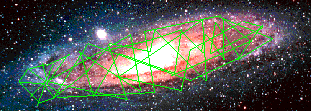

"If we could but see it, this is what every star in the galaxy looks like, sort of a sea urchin if you will, a star making images of every other star, starting at the minimum distance and going out to infinity. The casting of very high-resolution images of the whole universe on the sky - and these images are in focus at all distances - is a really remarkable thing."
(Drake discussing the ideas of Eshleman in The Search for Extraterrestrial Intellingence, by McDonough, Wiley (1987))
Maybe we will discover a GRB CETI Communications Network if we carry out the exploration program suggested by Robin Corbet in his paper The Use of Gamma-ray Bursts as Direction and Time Markers in SETI Strategies, astro-ph/9904268, in which he says:
"When transmitting a signal over a large distance it is more efficient to send a brief beamed signal than a continuous omni-directional transmission but this requires that the receiver knows where and when to look for the transmission. ... gamma-ray bursts may well the best "synchronizers" of all currently known phenomena due to their large intrinsic luminosities, high occurrence rate, isotropic sky distribution, large distance from the Galaxy, short duration, and easy detectability. ...".
For Classical Shannon Information Theory, Lachmann, Newman, and Moore, in cond-mat/9907500, say:
"... It has been well-known since the pioneering work of Claude Shannon in the 1940s that a message transmitted with optimal efficiency over a channel of limited bandwidth is indistinguishable from random noise to a receiver who is unfamiliar with the language in which the message is written.In this letter we demonstrate an equivalent result about electromagnetic transmissions.
We show that when electromagnetic radiation is used as the transmission medium, the most information-efficient format for a given message is indistinguishable from black-body radiation to a receiver who is unfamiliar with that format. The characteristic temperature of the radiation is set by the amount of energy used to make the transmission.
If information is not encoded in the direction of the radiation, but only its timing, energy or polarization, then the most efficient format has the form of a one-dimensional black-body spectrum
which is easily distinguished from the three-dimensional case. ...
... For the case where the transverse momentum of photons is not used to encode information, or for broadcast transmissions, the spectrum is indistinguishable from that of a one-dimensional black body. We have also shown that the characteristic temperature of the message is simply related to the energy used to send it, and we have derived an upper limit on the rate at which information can be transmitted in both cases. ...
... we speculate that results similar to those presented here may apply to transmissions using other radiative media as well. Since many natural processes maximize the Gibbs-Boltzmann entropy, they should give rise to spectra indistinguishable from optimally efficient transmissions. For instance, if we had a transmitter that can emit any type of particle (rather than just photons), it seems plausible that the optimal spectrum of particle types and energies would be that of Hawking black-hole radiation...".
In astro-ph/9810270, Schaefer and Walker say: "The Gamma Ray Burst GRB920229 has four extreme and unprecedented properties; a rise in brightness with an e-folding time scale of 220 +/- 30 microsec, a fall in brightness with an e-folding time scale of 400 +/- 100 microsec, a large change in spectral shape over a time of 768 microsec, and a sharp spectral cutoff to high energies with delta E / E = 18%. The rapid changes occur during a spike in the light curve which was seen 0.164 sec after the start of the burst. The spectrum has a peak nu F_nu at 200 keV with no significant flux above 239 keV, although the cutoff energy shifts to less than 100 keV during the decay of the spike. ..."
In astro-ph/9810271, Walker and Schaefer say: "... We have shown that the majority of GRBs have flickering with rise times faster than four milliseconds, while individual flares can vary with rise times as fast as 220 microseconds. ..."
In astro-ph/9710064, Cohen, Piran and Narayan show that observed data is best modeled by an intrinsic lower energy cut-off at 120 keV and that there is an observational bias agains detecting bursts with hardness energy over 500 keV by current detectors. Therefore, they suggest that a large population of unobserved hard gamma-ray bursts may exist.
"... Unlike the single instrument spectra, the composite spectrum of GB 920622 averaged over the total burst duration ranging from 20 keV up to 10 MeV cannot be fit by a single power law. Instead, the spectrum shows continuous curvature across the full energy range.
"... A high temperature (about 100 KeV or higher) blackbody model does not fit at all.
"... no quiescent X-ray counterpart candidate for GB 920622 has been found."
In a letter to Nature (372 (15 Dec 95) 616, 652) Hurley et. al. describe a burst on 17 Feb 94 that lasted 90 minutes and contained at least one 18 GeV photon.
BATSE, on 27 Oct 96 and 29 Oct 96, detected 4 GRBs from the same part of the sky. The 27 Oct GRBs were at UT times 42,247 sec and 43,322 sec, and locations RA 67.4 and 68.7, DEC -42.4 and -54.3, with durations 100 sec and 0.9 sec. The 29 Oct GRBs were at UT times 23,677 sec and 24,350 sec, and locations RA 59.4 and 59.8, DEC -52.6 and -48.9, with durations 30 sec and 750 sec. The uncertainties in position of the 4 GRBs were 5.6, 5.8, 4.6, and 0.3 degrees, respectively.
Gamma Ray Bursts (and other things) are discussed on Robert J. Nemiroff's home page and in his recent papers.
BATSE has detected 12 gamma-ray flashes from earth. For 7 of them, concurrent weather images were obtained, and all 7 seem to be related to thunderstorms (Sky and Telescope, Jan 95, p. 14, and Fishman et. al., Science (27 May 94) 1250, 1313).
Some thunderstorms extend to 10 miles altitude, and have
red sprites at altitudes from 30 to 60 miles,
and circular elves at altitudes from 60 to 70 miles,
as illustrated and described in the July 1997 issue of Discover magazine:
that shows lightning below the blue jets.
In a web article for Scientific American Explorations, W. Wayt Gibbs in San Francisco writes:
"The ancients imagined thunderstorms and lightning to be evidence of titanic war among the gods in the sky above. ... one can indeed find wonders: ... exotic stabs of illumination called sprites and elves. ...... it wasn't until 1994 that a team out of the University of Alaska at Fairbanks, circling around midwestern thunderstorms in a jet aircraft, obtained the first color images of sprites. These snapshots show that sprites are colorful (usually red), quite enormous and often surprisingly delicate in form. Some sprites stretch upward 95 kilometers (58 miles) from the cloudtops. They always seem to appear just as a lightning bolt--usually an especially fierce one--strikes down toward earth, and they almost always appear in groups.
Investigators now think sprites probably occur when an unusually potent stroke of lightning creates an intense electrostatic field above the cloud from which it emanates. Ions (electrically charged atoms) and electrons floating about the atmosphere are heated by this field and glow red in response, scientists speculate. ...
When researchers pointed their cameras to pick up sprites, they were surprised to discover that other bizarre light shows also illuminate the high altitudes. Vast blue jets, rising from clouds at 300 times the speed of sound in air, form cones of light that stand 40 kilometers tall. ...
Blue jets may be formed when such conditions happen to occur just as a cosmic ray (an extremely fast moving particle kicked out of a supernova or some other energetic cosmic event) collides with an air molecule in that region. The collision produces a shower of fast electrons; the upward-pointing electrostatic field above the cloud can accelerate these electrons further, to energies at which they emit blue light. ...
... a group of Stanford University researchers, led by Umran Inan of Stanford University, reported at the American Geophysical Union meeting in San Francisco that they had clocked yet another form of stratospheric lightning, one that, paradoxical though it may seem, propagates faster than the speed of light. These halos of red light, dubbed elves, were first conclusively recorded by Japanese scientists in 1995. But little was known about their structure and movement until Inan's group imaged the phenomenon with The Fly's Eye--a custom-built instrument that chains together 12 highly sensitive photodetectors, each in its own 45-centimeter (18-inch) barrel and each pointing to a different part of the sky.
The Stanford researchers managed to get a good look at 10 elves. All started just above a groundstroke of normal lightning but expanded into rings up to 300 kilometers (200 miles) across in less than a thousandth of a second. Although the elves appear to spread faster than light, analysis of the physics behind elves demonstrates that no particles actually move that fast, so Einsteinian relativity is not violated. The faster-than-light illusion seems to be caused by successively distant air molecules lighting up in rapid-fire sequence, like the strobe lights running along an airport runway.
Inan and Yuri Taranenko of Los Alamos National Laboratory have developed mathematical models which they think may explain what causes elves. According to their simulation, the key is the electromagnetic pulse produced by lightning strokes. This pulse expands like a balloon, upward and away from the groundstroke. If the pulse is strong enough, the theory goes, it energizes the ions and free electrons at the border between the stratosphere and ionosphere enough to make the charged particles shine red.
So, although the electromagnetic pulse expands at exactly the speed of light, Inan explains, the ring of shining particles formed at the lower edge of the ionosphere grows faster--just as a balloon released underwater will, as it breaks the surface, create a ripple that moves much faster outward than the rate at which the balloon rises upward. Zeus himself might be impressed.".
According to an article by Nicola Jones on page 18 of the 8 February 2003 issue of the New Scientist:
"... Just before a flash of lightning ... a huge blast of X-rays or other high-energy particles is released. ... In 31 of 37 [lightning] strikes ... [in a field in Florida] a short burst of energetic radiation ...[was observed]... lasting 10 to 100 microseconds, just before the flash. The huge amount of energy - more than 10,000 electronvolts per particle - ...[means that]... anyone standing close to a lightning strike will get a ... dose of X-rays, of about the same energy as an X-ray at the dentist. ... One way X-rays could be generated is if electrons were being ripped away from air molecules and accelerated close to the speed of light. Such "runaway electrons" are seen in fusion experiments. But researchers did not expect to see them in lightning, where the surrounding air should act to slow the electrons. ...".
John Gilman, in his paper Ball Lightning and Plasma Cohesion, physics/0302063, says:
"...The phenomenon of ball lightning has been observed for a long time, but the nature of these luminous balls has been unknown. It is proposed here that they consist of highy excited Rydberg atoms with large polarizabilities that bind them together. Thus the cohesion of the balls comes from photon exchange forces (London dispersion forces) rather than the more usual electron exchange (chemical) forces. ...... Laboratory microwave plasmas persist for 200 ms. ...
... The cohesion in plasmas generated at the back faces of detonating explosives has a similar basis. ... the plasmas have enough cohesion to turn sharp corners (180 deg.) when guided by glass tubing; indicating that the plasma has little shear stiffness.... the plasmas persist long enough to travel in air for a few meters (of order microseconds). ...
... The lifetimes of lightning balls may be ... 10-100 seconds ... Since lightning balls are observed to travel horizontally for considerable distances, and they are translucent, their densities must be comparable with that of air ... They have been reported to pass through openings smaller than themselves ... The observed diameters of ball lightning spheres ... range from 0.02 to 1.5 m. with an average of 0.25 m. Take 0.2 m. as typical, or a radius of 10 cm. This corresponds to the maximum possible Rydberg orbital, rR ... the average rR is about 3 cm. At this radius the binding energy of an electron to its positive ion is very small, but the polarizabilty ...[ 4 pi rR^3 / 3 ]... of the average Rydberg atom is very large. ...".
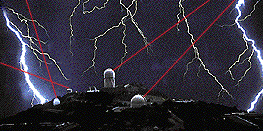 .
.
Tony Smith's Home Page ......